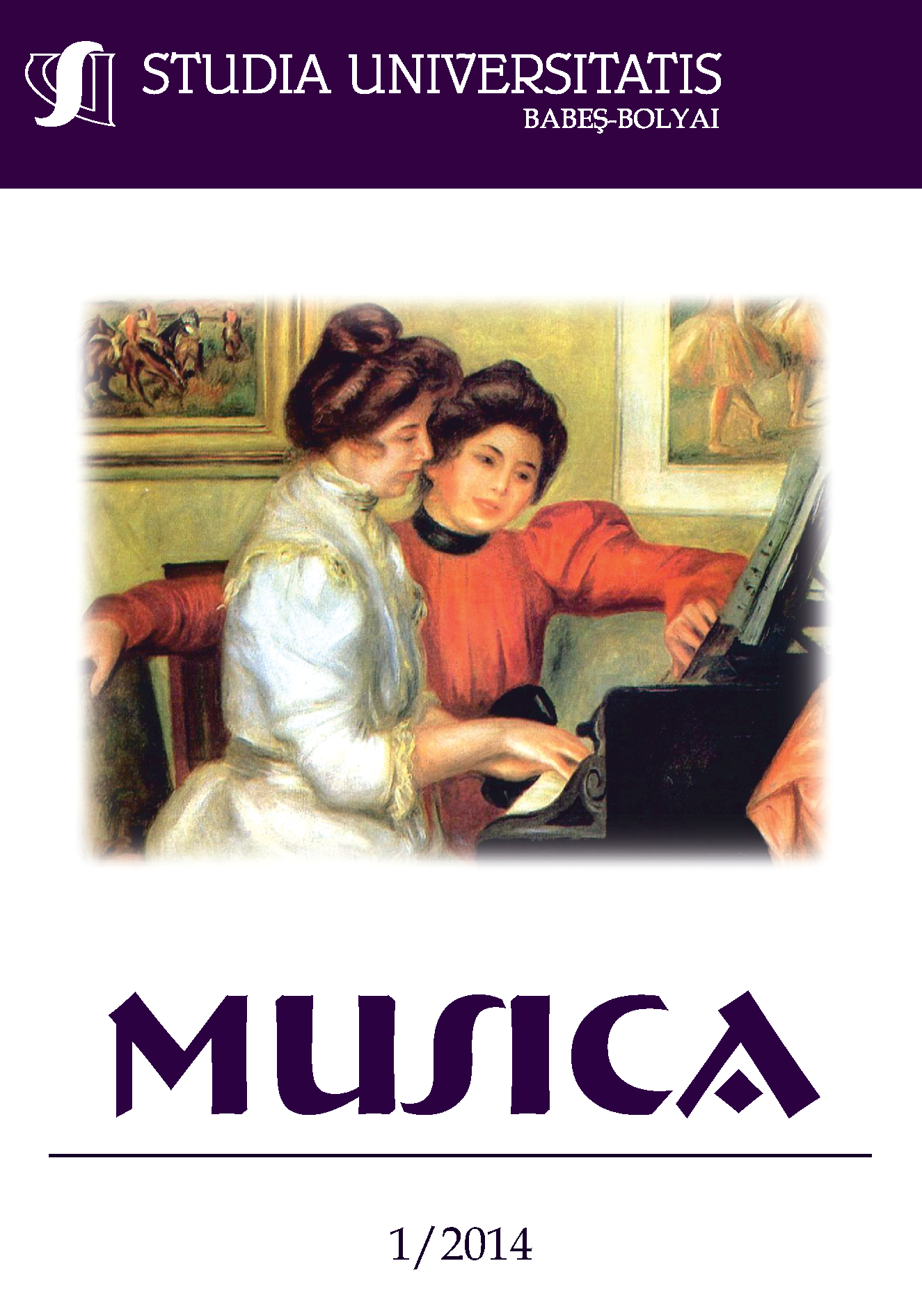„INTERNET SYMPHONY No. 1”: RETHINKING THE ORCHESTRA AS A VIRTUAL COMMUNITY
Keywords:
Internet, Symphony Orchestra, YouTube, Virtual Choir, Digital TechnologyAbstract
The article outlines, from a historical and sociological perspective, the evolution of the Symphony Orchestra from its origins (Vingt-quatre violons du roi) to its most recent incarnation as a product of current information technology: the YouTube Symphony Orchestra. The project recreates the ensemble as a virtual community, exploiting advances in technology to convert the artistic act into a transmedia product; it includes a selection process by video and e-mail, and online educational assistance for the musicians, followed by the video ’mash up’ of selected candidates, constituting the final version of Tan Dun’s piece Internet Symphony No. 1. Not being a single case, it has a ‘vocal’ equivalent in Eric Whitacre’s Virtual Choir, which is in fact a mix of 185 tracks individually recorded. The interaction between musicians is redefined within a multiplicity of contexts, providing a new framework for conceptualizing the artistic act as a matrix of integrative “multi-track creativity”.
References
Adamson, John, The Princely Courts of Europe. Ritual, Politics and Culture under the Ancien Régime. 1500-1700, Weidenfeld and Nicolson, London, 1999.
Burkholder, J.P., The Twentieth Century and the Orchestra as Museum, in The Orchestra: Origins and Transformations, Charles Scribner’s Sons, New York, 1986, pp. 409–433.
Campbell, John L., Problems of institutional analysis, in John L. Campbell “Institutional Change and Globalization”, pp. 1-30, Princeton University Press, 2004.
Camurri, Antonio; Canepa, Corrado; Volpe, Gualtiero, Active Listening to a Virtual Orchestra through an Expressive Gestural Interface: The Orchestra Explorer”, on “Proceedings of the 2007 Conference on New Interfaces for Musical Expression” (NIME07), pp. 56-61.
DiMaggio, Paul J.; Powell, Walter, The iron cage revisited: institutional isomorphism and collective rationality in organizational fields, in: “American Sociological Review” 48(2), 1983, pp. 147-160.
Inglehart, Roland, Modernization and Postmodernization: Cultural, Economic, and Political Change in 43 Societies, Princeton, NJ, Princeton University Press, 1997.
Lehmann, Bernard, L´orquestre dans tous ses éclats. Ethnographie des formations symphoniques, La Découverte, Paris, 2005.
Lunenfeld, Peter, The digital dialectic: new essays on new media. Cambridge, Massachusetts: The MIT Press, 1999.
Minsky, Marvin, The emotion machine: commonsense thinking, artificial intelligenceand the future of the human mind, Simon & Schuster, New York, 2006.
Morales, Nicolás, L´artiste de cour dans l´Espagne du XVIII-éme siécle. Étude de la Communauté des musiciens au service de Philippe V (1700 – 1746), Bibliothéque de la Casa de Velazquéz, Vol. 36, Université de Savoie, Chambery, Annecy.
Owen, Marque, A Very Grand Finale, Telstra Exchange Community, April 6, 2011
Piscitelli, Alejandro, Internet, la imprenta del siglo XXI, Gedisa Publishing House, Barcelona, 2005.
Pomfret, Emma, A potent mix of composerly skill, anti-elitism and great hair, Eric Whitacre is about to wow audiences this summer, in “The Times”, London, August 7, 2012.
Rayner, Henry, The Orchestra: A History, Charles Scribner´s Sons, New York, 1978.
Ross, Alex, The Well-Tempered Web. The Internet may be killing the pop CD, but it´s helping classical music, in ”The New Yorker”, 22 Oct. 2007.
Roux, Marie-Aude, La renaissance des 24 Violons du Roi-Soleil, in ”Le Monde”, 19 Oct. 2008, Paris.
Solnon, Jean François, La Cour de France, Fayard, Paris, 1987.
Spitzer, John / Zaslaw, Neil, The Birth of the Orchestra. History of an Institution, 1650 – 1815, Oxford University Press, 2004.
Suguru, Goto, Virtual Musical Instruments: Technological Aspects and Interactive Performance Issues, in „Trends in Gestural Control of Music”, Paris, IRCAM, 2000, pp. 217-230, Marcelo M. Wanderley/Marc Battier Publishing House.
Suguru, Goto, The Aesthetics and Technological Aspects of Virtual Musical Instruments: The Case of the SuperPlom MIDI Violin, in”Leonardo” Journal No. 9, 1999, pp. 115-120.
Toffler, Alvin, The Third Wave, William Morrow, New York, 1980.
Ţiplea Temeş, Bianca, Quo vadis, Orchestra simfonică? Traiectoria unei entităţi artistice între “La Grande Bande” şi “YouTube Symphony Orchestra”, in “Intermezzo”, no. 3/March, 2009, pp. 28-31, Ed. MediaMusica, Cluj.
Välimäki, T. / Takala, T., Virtual musical instruments – natural sound using physical models, in ”Organized Sound,” Vol.1, Issue 2, 1996, pp. 75-86.
Wakin, Daniel J., Getting to Carnegie Hall via Youtube, New York Times, Dec. 1, 2008.
Wanderley, M. M. / Battier, M., (Eds.), Trends in Gestural Control of Music, IRCAM - Centre Georges Pompidou, Paris, 2000.
Wilhelm, Mitchel, Metacreation. Art and Artificial Life”, MIT Press, Cambridge MA, 2004.
Wilson, Stephen, Information Arts: Intersections of Art, Science and Technology, MIT Press, Cambridge MA, 2003.
Downloads
Published
How to Cite
Issue
Section
License
Copyright (c) 2014 Studia Universitatis Babeș-Bolyai Musica

This work is licensed under a Creative Commons Attribution-NonCommercial-NoDerivatives 4.0 International License.



